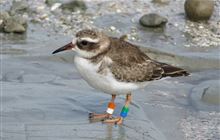Tūturuatu evacuated from Motutapu
Archived content: This media release was accurate on the date of publication.
Introduction
Ten critically threatened tūturuatu/shore plover have been evacuated from Motutapu Island and relocated to captive facilities while DOC hunts a stoat.Date: 03 March 2021
The birds, nine adults and one juvenile, were relocated on the 10 February to Cape Sanctuary in Hawke’s Bay and Pūkaha National Wildlife Centre in the Wairarapa, two of the three captive breeding facilities that support the Tūturuatu Recovery Programme.
In December 2020, two male tūturuatu were found dead in their nests, with DNA and post-mortem signs signalling a stoat was responsible.
A further two male tūturuatu have been killed by the stoat, resulting in the loss of all but one chick from this breeding season – a devastating blow to the small population, which has struggled to establish on Motutapu.
DOC Technical Advisor and lead of the Tūturuatu Recovery Group, Dave Houston, says the decision to evacuate the birds required careful consideration of different conservation pressures.
“We have had to consider the impacts of disrupting breeding, the likelihood of the stoat being caught, and available capacity in captive facilities. It also takes time to organise translocations and capture birds in the wild.”
An incursion response is underway to catch the stoat, which involves servicing an extensive network of over 400 traps across Motutapu and Rangitoto. Conservation dogs and trail cameras are also being used, with a Technical Advisory Group providing expert advice on the operation.
Dave Houston says the birds will remain in the facilities until the end of April.
“Ideally, we would hold these birds in captivity until the island is once again declared pest-free, however the captive facilities have limited capacity as chicks hatched at these sites are coming of age and require more space. This means we have to return the birds to Motutapu before the end of April.
“Releasing the tūturuatu elsewhere is not a possibility as they are site-fixed and will attempt to return to their home of Motutapu. There are also limited safe habitats for these small shorebirds, and existing islands are already near population limits.”
The current stoat incursion follows a previous detection and response in May 2020, which resulted in a stoat being trapped in September. Following this, mustelid detector dogs did not find further evidence of stoats on Motutapu or Rangitoto.
Additional management measures will be planned with advice from the Tūturuatu Recovery Group to support the population.
More information
Tūturuatu are little birds with big personalities.
Tūturuatu nest on the ground, making them highly susceptible to introduced predators like rats, stoats, and cats. Their survival relies on island biosecurity, captive breeding, and translocations to predator-free islands.
Tūturuatu populations exist on Rangatira/Hokorereoro and Mangere Islands in the Chatham Islands, Waikawa/Portland Island in Hawke’s Bay, and Motutapu in the Hauraki Gulf.
The populations on Rangatira and Waikawa are at or approaching capacity, which means new places to establish new populations are required to support the population. Finding habitats which are suitable and safe is a challenge to find so predator free island locations such as Motutapu are incredibly important to assist Tūturuatu population recovery.
Contact
For media enquiries contact:
Email: media@doc.govt.nz

